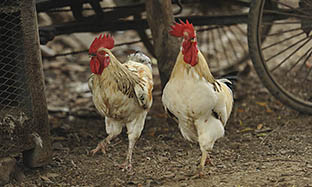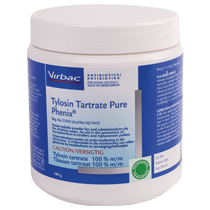
Mycoplasma gallisepticum (MG)
M gallisepticum (MG) is commonly involved in "chronic respiratory disease" of chickens and "infectious sinusitis” in turkeys. These diseases affect chickens and turkeys worldwide, causing economic losses in commercial operations, and are commonly seen in non-commercial flocks. Infection also occurs in pheasants, partridges, peafowl, pigeons, quail, ducks, geese, and psittacine birds.
Respiratory symptoms: conjunctivitis, facial skin oedema and tear secretion
MG is the most pathogenic avian mycoplasma in chickens, although M synoviae (MS) is also present in the country.
MG is transmitted vertically within some eggs from infected breeders to progeny (broilers or commercial layers) and horizontally via infectious aerosols. MG can spread through contamination of feed, water, feathers, and by human activity on shoes & equipment. Flock-to-flock transmission occurs readily by direct or indirect contact from the movement of birds, people, or equipment from infected to susceptible flocks. Some potential reservoirs of MG are backyard flocks, multiple-age layer flocks, and free-ranging poultry.
Good management and biosecurity practices are necessary to ensure that MG infections are not introduced to commercial poultry from these and other sources. In many outbreaks, the source of infection is unknown. Cold weather, poor air quality, concurrent infections, and some live virus vaccinations may facilitate infection, disease, and transmission.
Once infected, birds may remain carriers for life. There is a marked interaction between respiratory viruses (i.e. Infectious Bronchitis), Escherichia coli, and MG in the pathogenesis and severity of chronic respiratory disease.
In chickens, infection may be in apparent or result in varying degrees of respiratory distress, with slight to marked rales, difficult breathing, coughing and sneezing. Nasal discharge and conjunctivitis with frothiness in the eyes may be present. Feed efficiency and weight gains are reduced. Commercial broiler chickens and market turkeys may suffer high condemnations at processing due to airsacculitis. In laying flocks, birds may fail to reach peak egg production, and the overall production rate is lower than normal. MG on its own does not result in egg shell abnormalities.
Uncomplicated MG infections in chickens result in relatively mild sinusitis, tracheitis, and airsacculitis. E coli infections are often concurrent and result in severe air sac thickening and puss, pericarditis, and perihepatitis.
History, clinical signs, and typical gross lesions may be suggestive of a MG infection. The diagnosis can be confirmed with serology, isolation or PCR. Mycoplasma isolates must be identified by species, because birds may also be infected with non-pathogenic mycoplasmas. E coli infection, Coryza, Newcastle Disease, Avian Influenza, and Infectious Bronchitis should be considered in the differential diagnosis and can act as inciting or contributing pathogens.
Rapid Plate Agglutination Test on serum (Left - negative, Right - positive)
Most strains of MG are sensitive to a number of antibiotics, including tylosin & tetracyclines, but not to penicillin’s. Regulations on the use of antibiotics in food animals are rapidly evolving and should be considered before use.
Phenix Oxytetracycline 20% FG & Promote 10% (tylosin) from Virbac can be used in feed for prevention & treatment of MG & MS
Prevention is based largely on obtaining chicks from MG free breeder flocks. These birds should be kept under good biosecurity conditions to prevent the introduction of MG, and monitored regularly with serology or PCR to continually confirm MG free status.
Inactivated, oil-emulsion vaccines (MG Bac) are available and help to prevent egg production losses, but not infection. Live vaccines (F-strain, TS-11) can be used during the growing phase to provide some protection during lay. Broilers are usually not vaccinated for MG.


